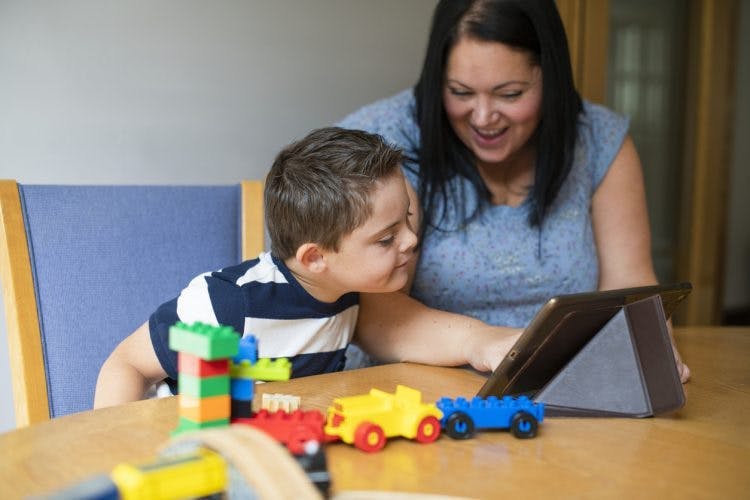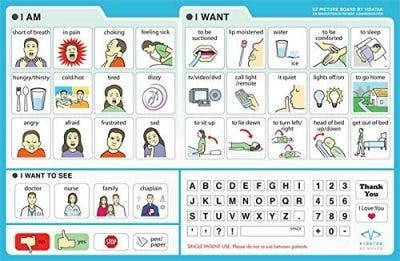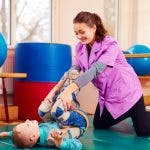Augmentative and alternative communication (AAC) can play a significant role in helping children with cerebral palsy develop effective communication skills and strategies.
Cerebral palsy can affect various areas of the body, including the muscles around the mouth. When the oral muscles are affected, individuals with cerebral palsy may be unable to speak.
With the help of AAC, children who are non-verbal can learn how to better communicate their needs. This article will go over different types of AAC for cerebral palsy and their benefits for communication.
Types of AAC for Cerebral Palsy
It’s important to understand that many children with cerebral palsy are cognitively intact and perfectly capable of typical learning. They can understand what you’re saying and know what they want to say back, but may be physically unable to verbally do so. This is where learning how to use AAC strategies can be extremely helpful.
All types of AAC for cerebral palsy require a bit of a learning curve, but the time spent practicing is well worth it! AAC can drastically transform the way your child communicates with the world around them.
Working with a speech-language pathologist is generally the best way to learn about and explore various types of AAC. A speech-language pathologist can assess your child’s current communication and motor skills in order to find an AAC option to fit their needs and abilities.
To help you understand what type of AAC may be ideal for your child, let’s go over the pros and cons of different types of AAC for cerebral palsy.
1. Speech-Generating Devices

Speech-generating devices utilize technology to help your child express themselves.
Generally, a speech-generating device will display written words or images representing commonly used words on a screen. All your child has to do is select the images or words they want to use, and the device will generate it in audio form.
If your child has poor fine motor skills or very restricted arm movement, there are also speech generating devices that scan eye movements. Your child can select a key by holding eye contact on a specific key for a few seconds.
Because it’s impossible for everything your child wants to say to be displayed on the device, most speech-generating devices will include a keyboard, which allows them to type anything else they want to say.
Oftentimes, these devices can be personalized to the child. For example, if your child is very interested in dinosaurs and talks about them frequently, they may have an option to add a shortcut to words like stegosaurus, T-rex, claws, and stomp.
Speech generators can be downloaded as an app on a tablet or sold as a single device. They are often able to be mounted onto a wheelchair for ease of use if needed.
This dynamic form of AAC allows for your child to communicate quickly and effectively.
2. Communication Boards

Not all forms of AAC need to be high-tech.
Communication boards are not technology-based, which may be ideal for individuals who do not want to worry about remembering to charge devices.
Like speech generating devices, they involve a pictographic display of commonly used words or phrases. However, the displays are presented in the form of a board or booklet.
A communication board does not involve any sound, so whoever your child is communicating with will need to be attentive to what your child is pointing at.
3. Body Language and Gestures

Body language is powerful and can be an extremely effective way to express how you’re feeling.
It doesn’t require any special technologies or displays and can be as simple as pointing to an object or shaking your head up and down or side to side. If your child’s cerebral palsy does not affect their hand movements, they can even learn how to use sign language. However, they will only be able to communicate if the other person also knows how to use sign language.
While speech is certainly not necessary for communication, relying solely on gestures and body language does require a little more guesswork. That can make this AAC for cerebral palsy dependent on the individual receiving the communication.
Benefits of AAC for Cerebral Palsy
AAC is essential for individuals with non-verbal cerebral palsy because it allows them to:
- Develop stronger relationships with others
- Express their thoughts and needs
- Be more independent
- Have more confidence
- Be more involved
- Have deeper and more complex conversations
- Experience less frustration and ultimately, have
better mental health
Humans are social beings. We connect by interacting with one another and trying to understand each other’s thoughts and emotions. The more connected we feel to one another, the safer and more comfortable we feel being ourselves.
Augmentative and Alternative Communication for Cerebral Palsy: Key Points
Cerebral palsy can affect the muscles around your mouth, which can make it difficult for individuals to speak.
Luckily, speech is not the only form of communication. Through AAC, people who are non-verbal can learn how to effectively express their needs, connect with others, and feel safe and confident in their own skin.










